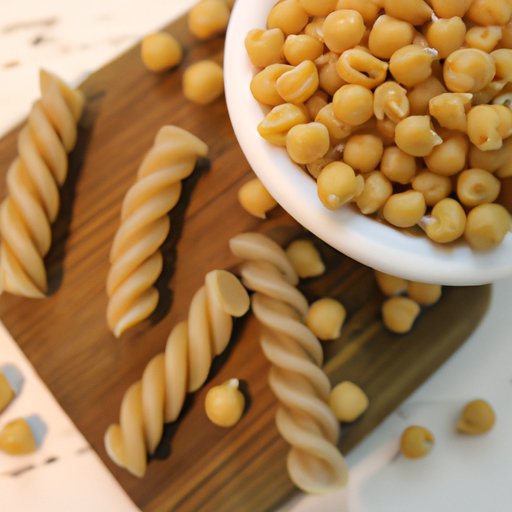
Introduction
Chickpea pasta has taken the market by storm as an alternative for people who love pasta, but cannot consume gluten found in traditional pasta. Gluten intolerance is a growing concern worldwide, and people must find alternative foods that are still delicious and nutritious. This article explores everything you need to know about chickpea pasta, from what it is to how it compares to traditional pasta for a gluten-free diet.
Everything You Need to Know About Chickpea Pasta and Gluten-Free Diets
Chickpea pasta is made entirely from chickpea flour. Chickpea pasta has fewer calories and carbohydrates because it contains more protein and fiber than traditional pasta. This makes it a healthier option compared to traditional pasta. On the other hand, a gluten-free diet is a diet where foods containing gluten are avoided. Foods such as pasta, bread, and beer cannot be eaten on a gluten-free diet. This diet is essential for someone with Celiac Disease, a condition that damages the small intestines when gluten is consumed. A gluten-free diet is also helpful in managing gluten sensitivity.
Gluten-Free and Delicious: Trying Out Chickpea Pasta
Chickpea pasta has a nutty flavor and can be used in various dishes like spaghetti, lo mein, and mac and cheese. Chickpea pasta is prepared the same way as traditional pasta, boil the pasta, and serve it with your favorite sauce. To maximize the flavor, add the chickpea pasta to the sauce and let it cook for a few minutes before serving. There are multiple chickpea pasta substitutes in the market. These include lentil, bean, and quinoa pasta. Lentil pasta is similar to chickpea pasta in nutritional value, while bean pasta has a stronger taste and requires additional seasoning. Quinoa pasta is more expensive and is not widely available in some areas.
Why Chickpea Pasta is a Better Gluten-Free Option
Chickpea pasta is an excellent substitute for traditional pasta for those on a gluten-free diet. Chickpea pasta is full of fiber and protein, making it more satisfying than traditional pasta. It is also lower in calories and carbohydrates, making it a healthier option for anyone looking to manage their weight. Chickpea pasta contains vitamins, minerals, and antioxidants which are essential for supporting a healthy immune system, reducing inflammation, and maintaining good digestion. These reasons make chickpea pasta a better alternative for those who are gluten intolerant.
The Pros and Cons of Chickpea Pasta for a Gluten-Free Diet
Chickpea pasta has several advantages in a gluten-free diet. Chickpea pasta is high in protein, fiber, and micronutrients, making it an excellent substitute for traditional pasta. Chickpea pasta is also more comfortable for digestion and reduces bloating. However, one of the drawbacks of chickpea pasta is its bland taste, which requires additional seasoning to enhance the flavoring. Additionally, chickpea pasta tends to be more expensive than traditional pasta, making it less accessible to some people.
Get Your Pasta Fix Without Gluten: Trying Out Chickpea-Based Noodles
Chickpea-based noodles are an excellent substitute for those looking for a gluten-free and delicious alternative. Chickpea-based noodles compare favorably to other gluten-free pasta substitutes like lentil, bean, and quinoa pasta. Chickpea-based noodles are rich in fiber and protein, making them more filling than traditional noodles. They are also gluten-free, making them an excellent option for people with Celiac Disease or gluten intolerance. Chickpea-based noodles are perfect for creating exciting dishes like veggie stir-fry, noodle soup, and spaghetti squash alfredo.
Chickpea Pasta vs. Traditional Pasta: Which is Better for a Gluten-Free Diet?
Comparing traditional pasta to chickpea pasta, chickpea pasta has a better nutritional profile. Chickpea pasta is a healthier option with less sugar and carbohydrates compared to traditional pasta, making it a better option for people with diabetes. Chickpea pasta also has more fiber and protein, which is vital in regulating blood sugar levels. Traditional pasta is higher in carbohydrates and calories, which can lead to weight gain if consumed in large quantities. People with Celiac Disease will also benefit from consuming chickpea pasta as it is gluten-free. In comparison, traditional pasta contains gluten, which can trigger the small intestine’s immune response.
Conclusion
Chickpea pasta is an excellent substitute for traditional pasta for those on a gluten-free diet. Chickpea pasta offers more fiber, protein, and micronutrients, making it a healthier alternative to traditional pasta. However, it has a bland taste, which requires additional seasoning to enhance the flavor. Chickpea pasta is perfect for creating exciting dishes like mac and cheese, spaghetti and meatballs, or noodle soup. The benefits of chickpea pasta make it an ideal substitute for those managing their weight or have Celiac Disease or gluten intolerance.





